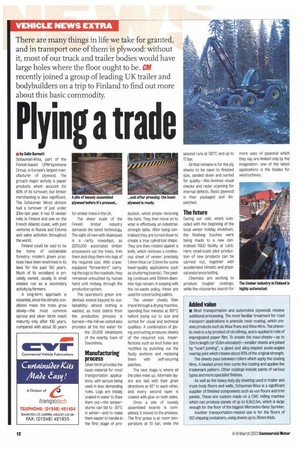Added value
Page 14

If you've noticed an error in this article please click here to report it so we can fix it.
• Most transportation and automotive plywoods receive additional processing. The most familiar treatment for road transport applications is phenolic resin coating, which creates products such as Wisa-Trans and Wisa-Wire. The phenolic resin is a by-product of oil refining, and is applied in rolls of impregnated paper film. To create the maxi-sheets—up to 12m in length (or 13.6m uncoated)—smaller sheets are joined by "scarf jointing", a glued and alloy-stapled acute-angled overlap joint which retains about 80% of the original strength.
The sheets pass between rollers which apply the coating films. A heated press then cures the coating and applies the trademark pattern. Other coatings include paints of various types and more specialist finishes.
As well as the heavy-duty ply sheeting used in trailer and truck body floors and walls, Schauman-Wisa is a significant supplier of finished components such as van floors and trim panels. These are custom made on a CNC milling machine which can produce panels of up to 6.9x2.5m, which is large enough for the floor of the biggest Mercedes-Benz Sprinter.
Another transportation-related use is for the floors of ISO shipping containers, using sheets up to 35mm thick.
































































































